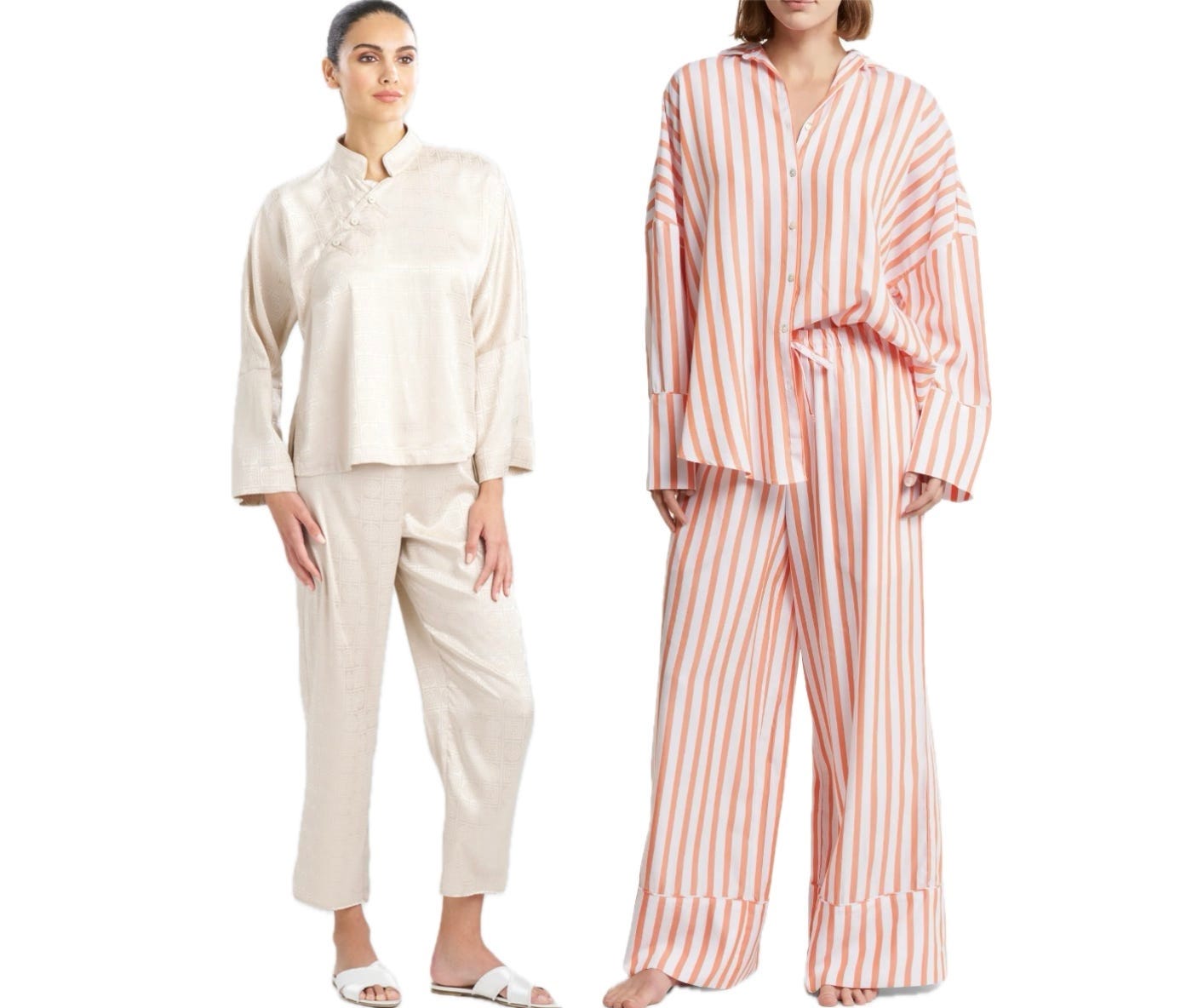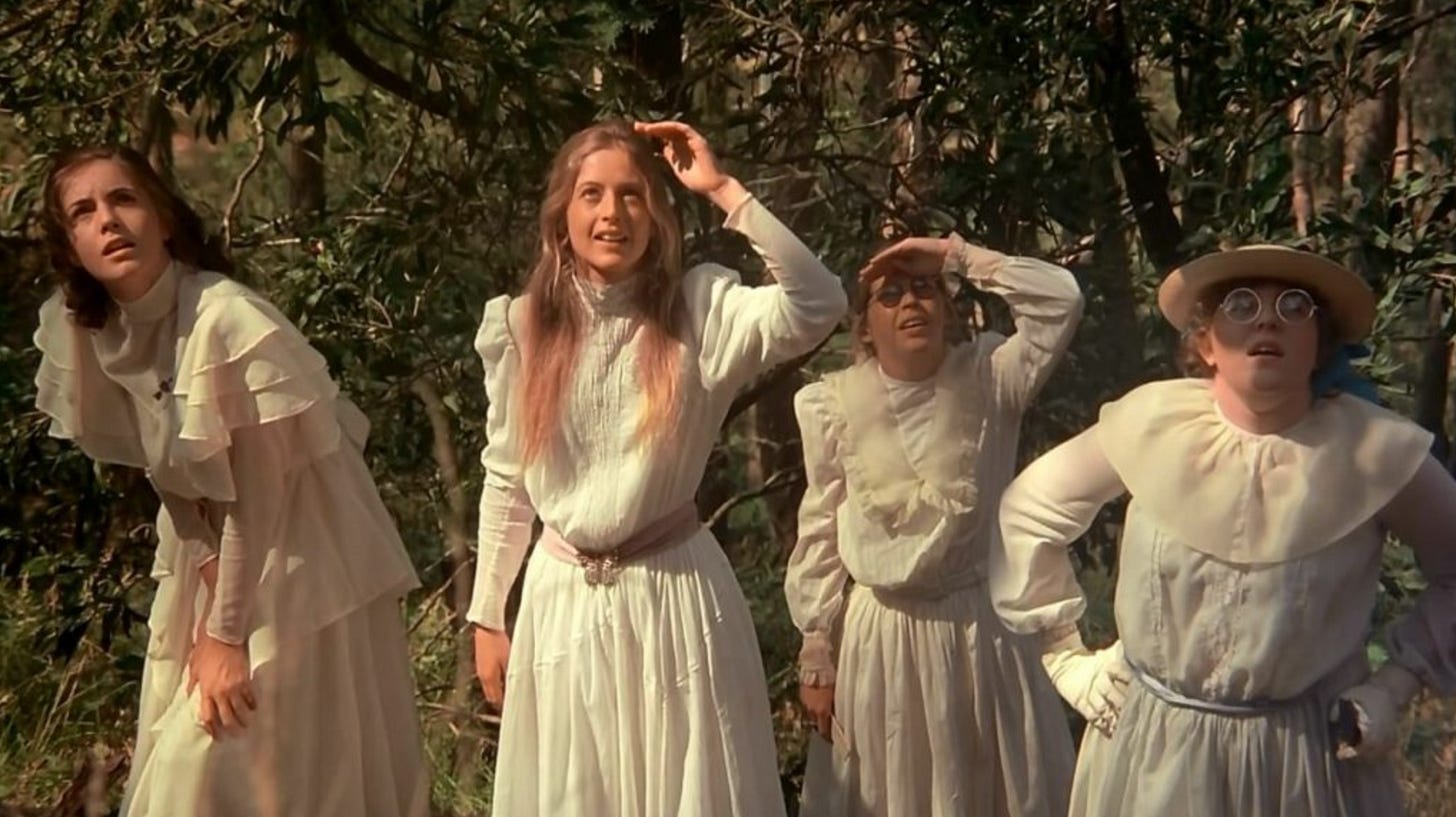How to get dressed with Rachel Tashjian Wise
The reporter and writer on clothes as a ritual for confidence, the melding of journalism and fashion, and writing as an experience of aesthetic pleasure
The most interesting thinkers have a way of expanding your mind when they share their perspectives. The best of them do it concisely and with precision, delivering only what needs to be spoken in order to get the point across. Rachel Tashjian Wise is one of these thinkers — the moment she opens her mouth, the surface area of your mind seems to stretch, letting her opinions percolate and meld with your own, ultimately shifting your purview, or creating new ideas.
Wise is fashion writer for the Washington Post, and author of the first invite-only natural style newsletter, Opulent Tips. She previously held roles as fashion news director at Harper’s Bazaar, fashion critic at GQ and deputy editor at GARAGE. Below, her thoughts on getting dressed, writing in fashion and the cardinal rule of corruption when it comes to basic clothes.
Read the last edition of How to get dressed with Anny Choi here.
Look 1: Getting dressed for work

The top and bottom I’m wearing are Cristaseya, which I got at an amazing archive sale in Paris during fashion week. The jazz shoes are from Repetto — they’re as comfortable as sneakers and when they get dirty, they look really cool. The scarf is from this woman named Anya who sells linen clothes from an old school house on the island where my husband’s parents live.
My mother in law told me I had to go see the clothes when we were there and I was intrigued that she was getting excited about clothes (she dresses very beautifully, but also very simply). If you are into [brands like] Casey Casey and Arts and Science, the woman who sells linen clothes from the school house scratches that itch.
I don’t usually wear the flourish (the scarf tied around my waist) if no one sees me [during the day] — but I do need a little something for a lift. Maybe it's an earring, maybe it's a weird shoe. Sometimes it's as simple as a red Johnston's of Elgin cashmere sock with my gold Charvet slippers. My first Lauren Manoogian purchase from four years ago was a gorgeous grandpa cardigan, which I keep on the back of my desk chair and throw on when I'm writing. It makes me feel alert and fancy.
When you work from home, you have to sort of break up your day and clothes are a really good way to break it up. I finish with work around 5 or 6 p.m., and at that point, I change into more traditional pajamas, and that’s usually what I wear when I’m having dinner.
Both pair of my evening pajamas (I have two) are from Nordstrom, which I love because it is such a great, classic department store in that they have true departments. The pajamas make me feel like I’m on the beach or the deck of a cruise ship or something. One pair is orange striped with oversize cuffs.
Then I’ll change into some kind of slip or underwear when I am actually going to bed.
I like to stay home most nights, but recently, we have been going out more. When the day is over, I like to read and to have my time.
[It’s not that I don’t like to socialize,] but I do like to limit it. In our industry, you can go to something every night if you want to, and being a writer, you are renting out your mind all day. And that is kind of what you do when you’re socializing too. So it is nice to have some time with myself after work.
What makes this look good? It works because it’s crispy and light — the fabrics are starchy, so they don’t cling and that [makes them feel more formal]. It feels put together.
The process of wearing clothes
But I do have this funny added process when I’m making an outfit. Being a fashion critic and writer has made me a more critical shopper. I am skeptical of a lot of brands, though I am also highly susceptible to the allure of fashion. (Otherwise I wouldn't be doing what I do.) But it's also made me very sensitive to the question of what we wear and what it says about us -- what we want to project or how it influences what others think about us.
I like looking like someone who enjoys the culture of clothes, for whom style is an intellectual pursuit. But other people might look at what I wear and think I look nutty. That's fine!
Maybe that’s why I’m so pointed in my writing. I’ve never cared what other people think about what I wear, in the sense that they think it looks "good" or "bad." I need to feel comfortable in my clothes above everything else.
Everyone in my family dresses in a really crazy way. I have a very expressive father. He has hundreds of brightly colored sweaters — his approach to getting dressed is costume-oriented but his work has nothing to do with his level of taste or style. [For most of my life], he worked in corporate communications.
I think there is something to having seen my family care about style and presentation but not work in it.
I’m usually up around 7 a.m. and I do a lot of my writing by hand because it’s not as intimidating as Going to The Computer to Write a Story. My best writing takes place in the morning because my mind is not cluttered yet so I can just bang it out. But it’s also a convenience because my editor is on the west coast so if I can something to her by 10 a.m., she’ll have it by the time she wakes up.
I usually walk the dog once or twice in a day, which takes about an hour in total, and then I have a lot of appointments that I run around to, so I’m actually not home that much. On the weekends, I’m barely here. Except in the evenings.
Look 2: Getting dressed for the weekend

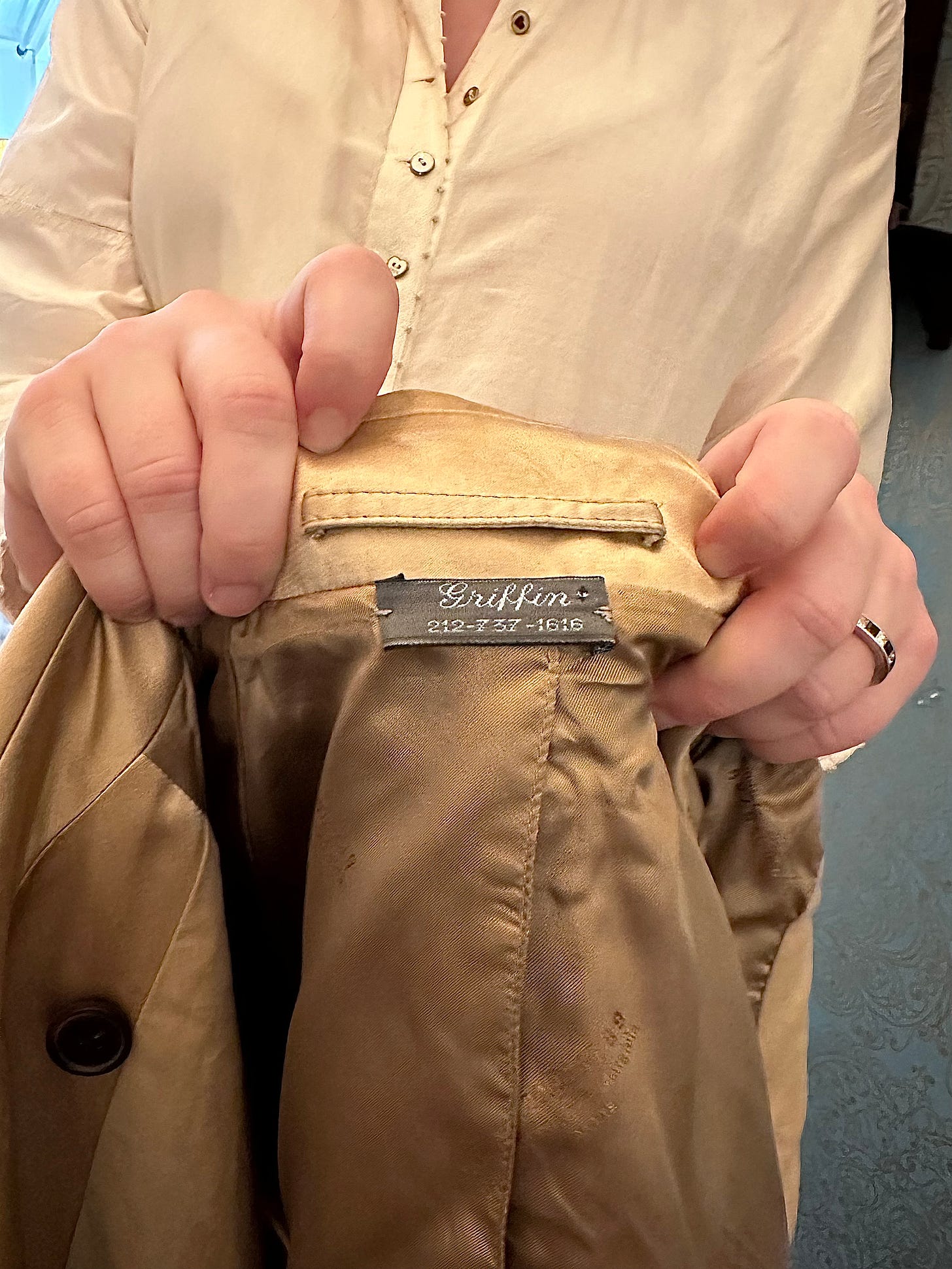
This dress is from Pero. Generally, I am attracted to simple pieces that are much more detailed than they seem. The coat is Margiela, which I got from The Real Real. The necklace is from [my husband,] Lloyd. It was a birthday gift that he sourced from an English Etsy dealer. The hat is Gigi Burris and the shoes are Carel.
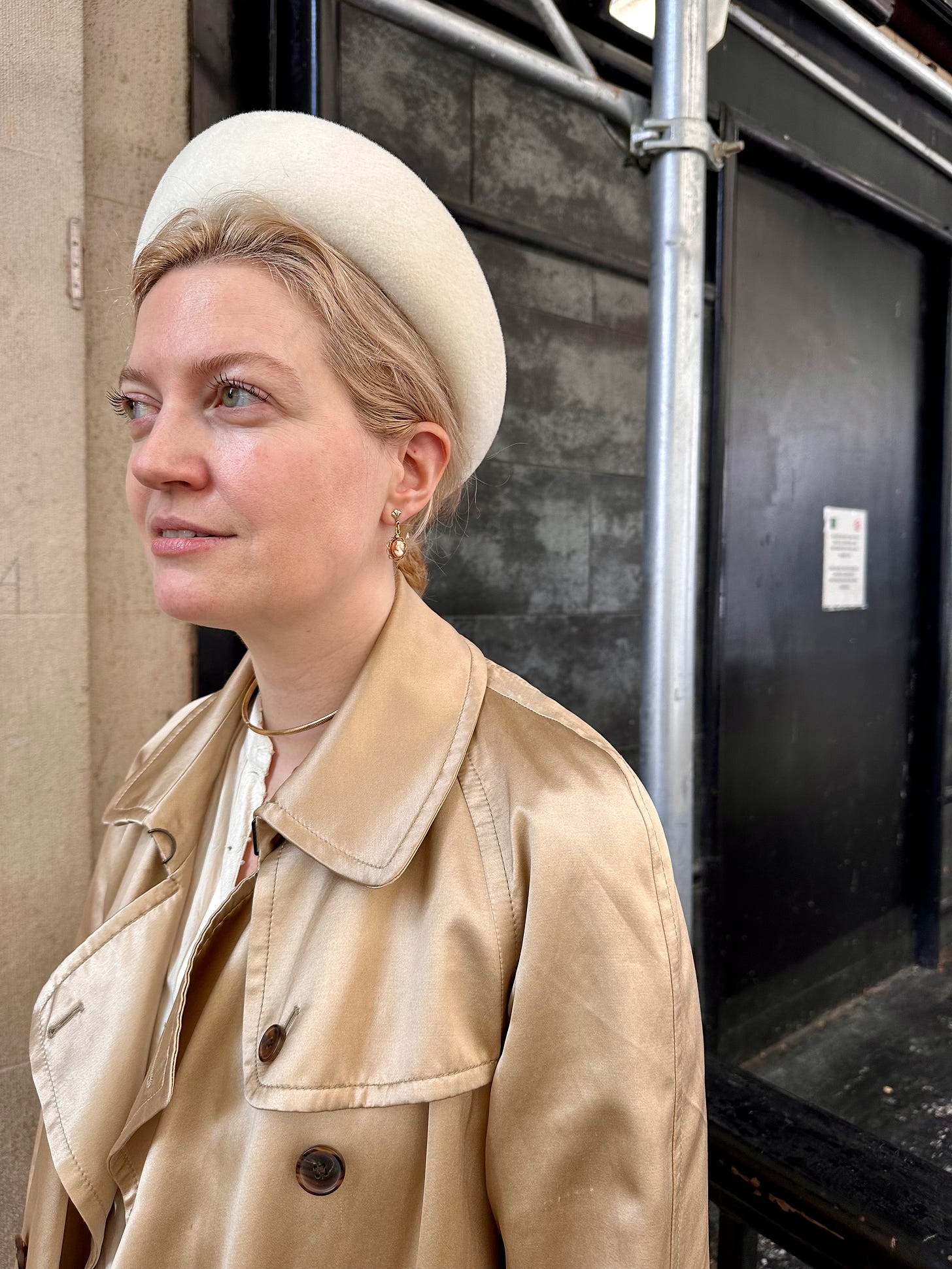
I shop The Real Real a lot — so I check for my brands when I’m there: Margiela, Lauren Manoogian, Casey Casey, Galanos, Prada.

It’s usually once or twice a week. But I don’t look at the site as a break from writing. I usually get up and move around. I try not to stay in the same place or at the computer when I take a break. The TRR checking is usually done when I’ve changed onto my evening pajamas.
[The outfit I’m wearing] would be like if we’re going to a museum or just for a walk or if I’m meeting up with friends for lunch (usually somewhere downtown).
Putting it together typically starts with something I really want to wear, and then I think about how to compliment it in a way that looks eccentric but not crazy. The ideas usually come to me when I’m in the shower or putting on my makeup.
There are practical factors too — I haven’t had a haircut in a while, for example, so I will put on a hat.
And I’m picky about shoes because they have to be comfortable — we always take a long family walk (Lloyd, me and the dog) in the morning and then go out to lunch.
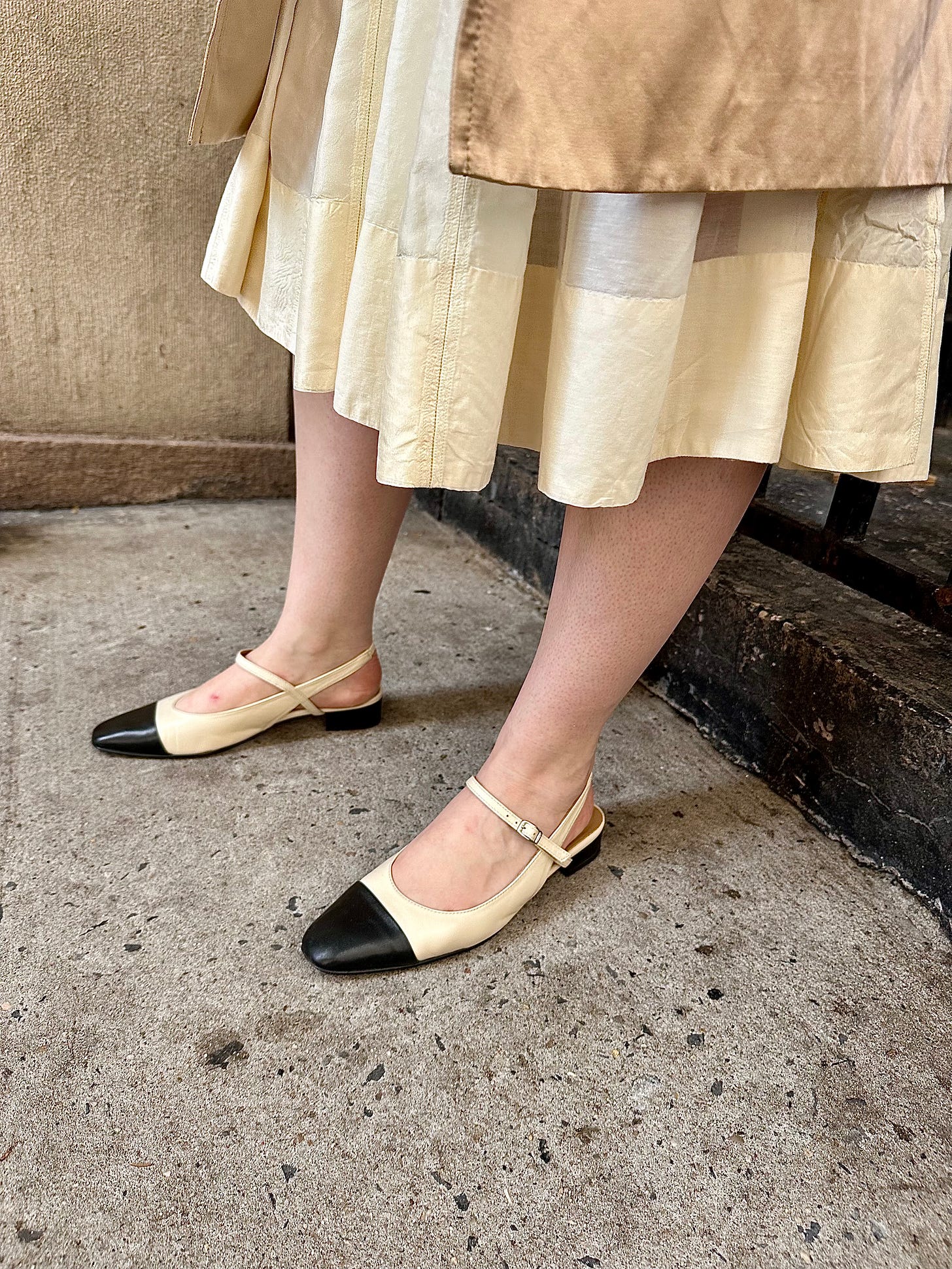
I also have friends over for dinner a lot. It’s less expensive and not as loud. My husband is a very good cook and what he makes is better than what you’ll get at a restaurant.
Thoughts on writing
I do work on the weekends too — I tend to work both days, probably because I have more time to write (usually the interviews are done by now, so I can get a head start on writing around them). I tend to write very quickly, and really like to write quickly. If something newsworthy happens, I can cover it and add a bit of context and explain it, then turn it around ASAP. But I enjoy doing interviews too — I really like preparing for them.
I try to immerse myself in that person's world -- I look at lots of old collections and new, read as many profiles as I can, try on their clothes in a store. When I interviewed Yohji Yamamoto last year, I went to two Alaia museum shows in Paris in the days before, because I knew they were very close friends. At first he was being really punk, almost sort of snarling at me between cigarettes, and then I started talking about the Alaia shows and Vionnet, and I think he realized we could have a conversation instead of an interview. Suddenly he became extraordinarily emotional: hilarious, mischievous, and spoke at length about losing his mother.
I always think about what people will want to talk about — really talk about, not their show or collection or next project or whatever. Like Daniel Roseberry and Sade, or Fran Lebowitz and the quality of furniture. I remember at the first Rodarte show I went to, Tim Blanks immediately asked the sisters about "Picnic at Hanging Rock.”
It wasn't in the show notes or hinted at, but he saw it in clothes. I thought, I've got to see and read and take in everything I can. It may not make it into the piece, but it makes the conversation and connection flow.
My personal writing is really my newsletter [Opulent Tips]. The nice thing about having a newsletter is that you can write about whatever you want. A list of books I’m reading, movies I’ve been watching.
And its ability to serve as an “experience of aesthetic pleasure”
I just watched "Hit Man" and I can't stop babbling about it. It's a 1940s screwball comedy mixed with a sendup of modern hunk culture. Otherwise I'm reading a zillion books right now. "Triumph of the Yuppies" for a piece I'm writing, the forthcoming Didion & Babitz book by Lili Anolik, and Griffin Dunne's new memoir.
I knew I wanted to write when I was very little. Like second grade. I liked reading and my parents and brother and grandparents would all read to me . It’s when I was in college that I realized I’d write about fashion. I was not necessarily into fashion but I was really into vintage clothes, and I liked fashion photography. [Being exposed to the writing of] Cathy Horyn and Judith Thurman and Robin Givhan — and then with you doing Man Repeller and Tavi [Gevinson] writing Style Rookie, and Laia Garcia with Geometic Sleep, I sensed writing in fashion was changing and that it could be more reflective and contextual.
There seems to be this perception that journalistic writing and fashion writing go in different buckets but something about the writing I was starting to read make it seem like you could meld journalism and fashion and that importantly, writing could be experience of aesthetic pleasure.
A lot of my readers share screenshots of my writing on social media -- sometimes I even see stuff floating around with no context, or even attribution to me. I love this. I love that writing can mean as much to a young person as a picture can. A woman recently told me she has a screenshot of my writing as her phone background! It was the greatest compliment ever.
I love thinking about women writing. I think so much about Didion "moving words around the page," or Toni Morrison conducting phrases in that incredibly spare way. You can see Robin Givhan's mind moving through each of her pieces, which always really excites me. I guess I don't really think about men writing. (I do think about Antonio Lopez drawing -- huffing and sweating. I think about that a lot.) Maybe it's because men have always felt like time is their own, and women often do not.
There’s this way of looking at fashion and ignoring one element of it to pursue another: the personalities of fashion, the circumstances of the industry, the history of clothes — but I like points of view that incorporate pieces of all of it.
The industry doesn’t work in such a way anymore where if Armani does something, everyone else is doing within a year — the nature of trends isn’t like that anymore but it does feel most important to pay attention to what the people at the upper echelons of the industry are thinking, doing, caring about so you can better understand what is happening at the ground level.
It’s not the unlock, but it all works together.
Look 3: Getting dressed to go out in the evening
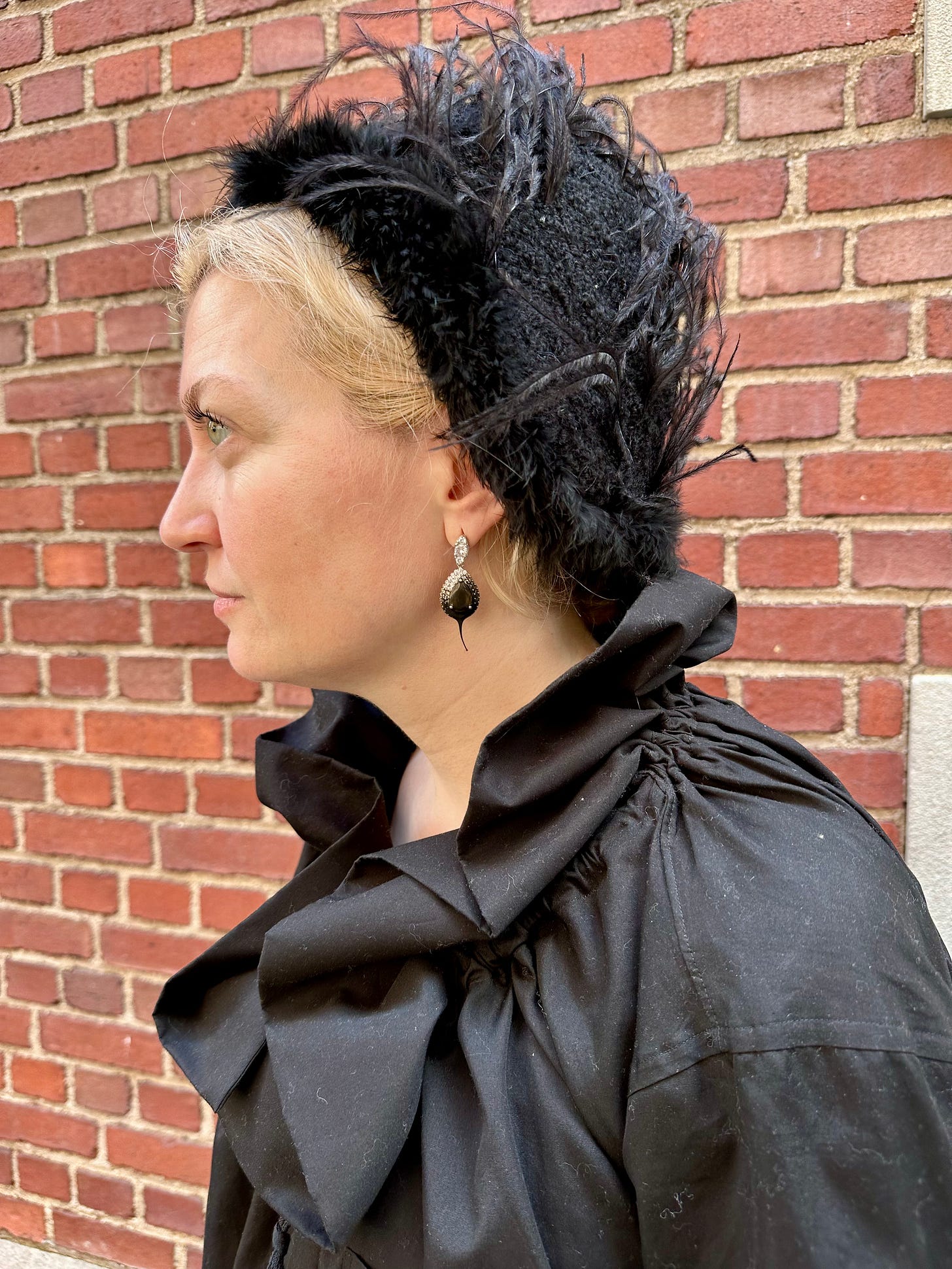
This dripping earring is from Ottolinger — I saw it in their show and e-mailed to ask if I could buy one. I don’t think people realize that literally anyone could do that. The other earring is from Necessary Clothing.
It’s probably ten years old. A place like Necessary Clothing is interesting because it’s an ecosystem unto itself with its own style codes and all, but anyway, what’s funny is that there was a French designer in town recently, she is the head of accessories at Hermes, and used to work at Alaia and designed the Demi Lune bag. We were talking and I asked her where she was most excited to go while here and she said Necessary Clothing.
Maybe it's the only place where fantasy still exists in fashion -- it's all going out clothing and fantastical fake jewelry. At the upper end of fashion, fantasy is just that. You're never going to really have that dress for life.
I also look at Zara and Shein all the time. I’m looking for trends, but I’m also always interested in whether obscure pieces are being knocked off and how.

The skirt I’m wearing is from Yohji [Yamamoto], the shirt is Comme des Garcons, the sandals are Manolo Blahnik. Do you go to the sample sale? It is so crazy. The hat is from Niklas Skovgaard. I love his stuff, it feels very 1930’s couture.
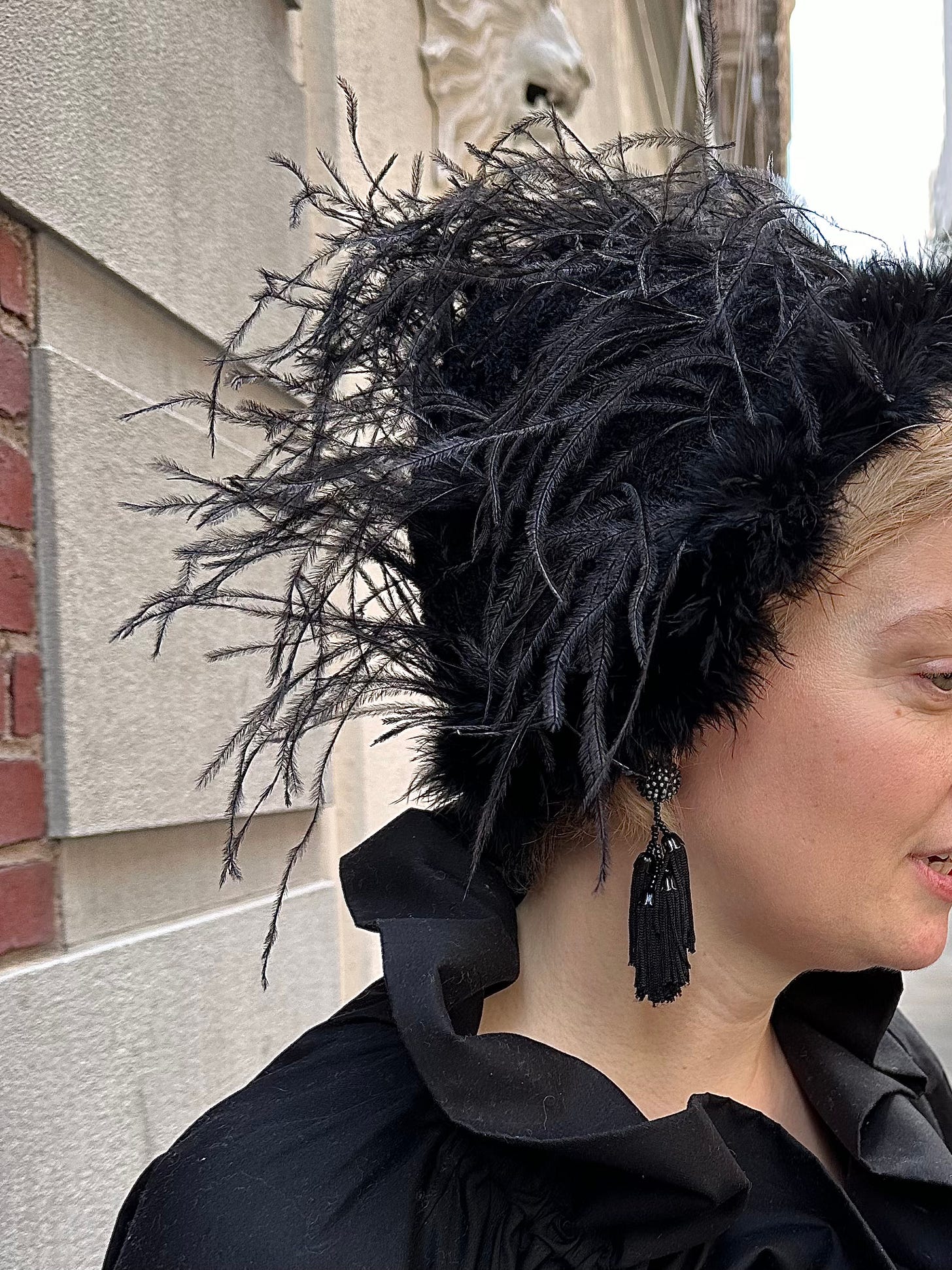
I discover a lot of great brands from SSENSE [like Niklas] or SC103, or Kiko — there is also good Comme des Garcons, but I really don't shop new very much.
Some of the brands I do shop [new] or pay attention to include Soeur, Favorite Daughter — a lot of the shopping I do is more like research.
I look at J. Crew and Alex Mill all the time and pay attention to where I’m being directed by other writers. What is Nikki Ogunnaike talking about? Who are you paying attention to? I also really like Subrina Heyink's Substack. And Tahirah Hairston's — she recently interviewed my friend Melvin, who is the most stylish guy in New York, with the coolest life, wife, apartment, daughter.
Tahirah also has awesome style. I always put her on my Opulent Tips best-dressed list at the end of the year.
The evolution of ‘chic’
How does it feel to me that everyone is a hat person now? Welcome to the party!
Because I worked with Samira [Nasr] so closely, I think of the word chic. She is actually chic, like in the original sense and I notice that everyone says “chic!” when you wear a hat.
The original sense of the word is: individual, strong, in many cases it is also eccentric and off-putting. It’s highly cultivated, maybe it’s a little dangerous, a little offensive.
But the way we use the word chic now is to describe what is easy and bourgeois even though the original chic is anti-bourgeois.
Clothing is pleasure. My medium is writing and that is different, but clothes have always felt like pleasure to me. It was something I would do after school. I would try on outfits — put on my mom’s clothes or my gradmother’s. I really like getting dressed. I don’t spend a lot of time doing it but it’s very pleasurable for me. It is a ritual that gives me confidence.
A lot of times people don’t understand
Keep reading with a 7-day free trial
Subscribe to The Cereal Aisle by Leandra Medine Cohen to keep reading this post and get 7 days of free access to the full post archives.




